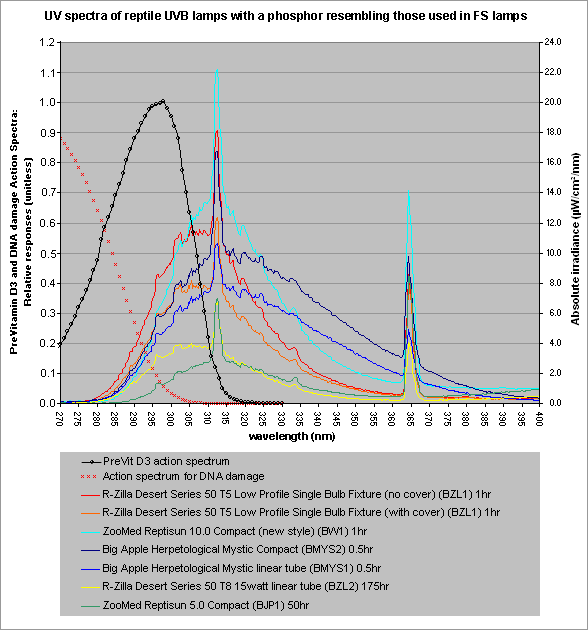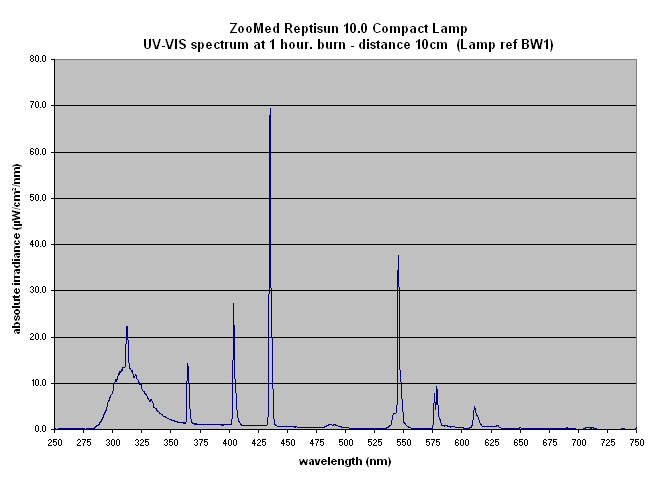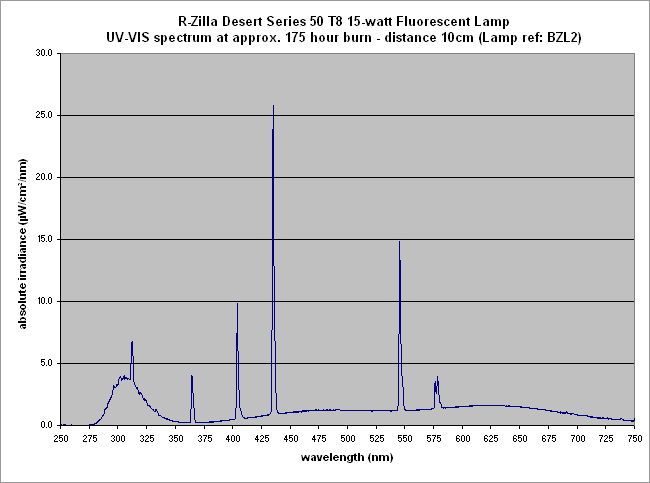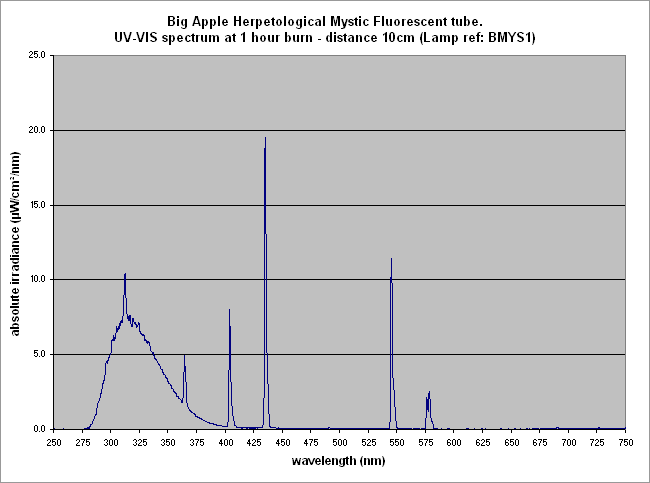|
Discussion:
The use of the "phototherapy" phosphor in reptile
lamps
If
you have not yet read the previous sections (in particular,
the lamp test results) we suggest you may wish to do so
before reading this section.
The
"phototherapy phosphor"
As we
described in the lamp test results, the spectra of the fluorescent
lamps which have been connected in some way with cases of
photo-kerato-conjunctivitis all appear to utilise a specific
phosphor, which is generating low wavelength UVB from a
threshold as low as 275 - 280 nm. (fig. 1)
 This
is the typical UV spectrum of the phosphor used in so-called
"FS" lamps. FS lamps are used for testing the deterioration
under UVB of resistant materials such as roofing and car
bodywork, and in older-style human clinical phototherapy
lamps. This
is the typical UV spectrum of the phosphor used in so-called
"FS" lamps. FS lamps are used for testing the deterioration
under UVB of resistant materials such as roofing and car
bodywork, and in older-style human clinical phototherapy
lamps.
Lamps
which contain a high proportion of this "phototherapy" phosphor,
and which have glass which does not block UVC, emit radiation
as low as 270nm.
However,
the lower wavelengths are apparently attenuated by reducing
the proportion of phosphor in the blend(15)
and by use of different glass. The Reptisun 10.0 lamp, for
example, does not emit UVB below 280-285nm; the Big Apple
Herpetological Mystic tube and the R-Zilla Desert 50 Series
T8 lamp emit UVB own to 275nm.
The
use of FS lamps and their spectra
FS lamps
include old-fashioned broadband UVB phototherapy lamps such
as the FS-T12/UVB series, also known as Philips TL-12 lamps
(14)
and UVB-313.(12)(13)
The typical spectrum of one of these lamps may be viewed
here
(external link; opens in new window;
pdf file - takes short time to load)
Other
similar products are known as FS-40 and F40UVB lamps, and
the phosphor which produces this typical UVB emission is
also described as "Sylvania 2096"(15).
FS lamps
were once widely used in broadband UVB (bUVB) phototherapy
tubes for treatment of diseases such as psoriasis, atopic
dermatitis and vitiligo, but recently, narrowband UVB phototherapy
(nUVB), with fluorescent bulbs emitting near monochromatic
UV around 311 nm, has become a preferred option.(16)
Eye protection is always worn when any of these lamps are
used in clinical work. These lamps are never used as tanning
lamps or for cosmetic purposes.
FS lamps
are also widely used for accelerated UV ageing and weathering
tests for quality control applications, testing very durable
materials such as roofing, exterior coatings for buildings,
and automotive paintwork.(12)
Why
would anyone put this phosphor in reptile lamps?
The
lowest wavelengths ever found in natural sunlight at the
earth's surface are 290 - 295nm; at higher latitudes little
below 300nm reaches sea level. In contrast, the phosphor
producing UV radiation in these lamps is emitting light
from as low as 275 - 280nm (close to the UVB/UVC boundary).
Its output increases sharply with increasing wavelength.
Maximum output is between 310 - 315nm, contributing to the
mercury peak at 313nm.
This
phosphor is therefore producing almost all its output right
in the middle of the "UVB" band. It is a very
efficient producer of UVB, in the scientific sense. If a
lamp specification required just "high UVB" then
undoubtedly this would be the phosphor of choice, if one
was not aware of the increasingly hazardous effect of the
low wavelengths as they fall towards UVC.
This
phosphor will also, undoubtedly, enable the production of
vitamin D3 in the skin. The action spectrum for the conversion
of 7DHC to previtamin D3 peaks at 298nm, which is therefore
the most effective wavelength for vitamin D3 production.(4)
However,
a significant proportion of the output is at wavelengths
below those found in natural sunlight, where the benefits
of high pre-vitamin D3 conversion may be outweighed by an
increased risk of cell damage.
The
presence of low wavelength UVB seems the most likely reason
for the increased incidence of photo-kerato-conjunctivitis.
It causes significant cell damage, particularly to DNA,
causing cell death. Although the delicate cells of the surface
of the eye would most likely be first to be noticeably affected,
and hence photo-kerato-conjunctivitis would be a first sign
of over-exposure to radiation, damage to other exposed areas
cannot be ruled out.
Many
species of reptile have very thick, armoured, protective
skin which may be quite resistant to damage from UV light;
our studies on UVB transmission through shed skin certainly
show that many sun-worshipping reptiles allow very little
UVB to reach deeper skin layers. Skin of some other species
appears not so protective - which may account for the skin
problems experienced by some chameleons under these lamps.
The risk of skin cell death and possible development of
skin cancer from damaged but surviving cells - which is
well documented in humans - must be a possibility, however,
even in sun-worshipping species exposed to very abnormal
radiation for extended periods of time.
Scientific
research using FS lamps
The
effects of longterm exposure of reptiles to these wavelengths
are not known. However, the effects of long-term exposure
of various mammals to broadband UVB (bUVB) phototherapy
tubes has been studied quite extensively, as lamps from
the FS series have been widely used to study cell damage
and immunosuppression, and induce skin tumours in laboratory
animals.(17)(18)(19)
Relatively
small amounts of non-solar spectrum UV energy can have significant
effects. In one study, non-solar radiation (UV at wavelengths
below those in sunlight - i.e. below 290nm) from FS lamps
was shown to penetrate sunscreens, and cause immunosuppression,
more than fifteen times as effectively as the solar
equivalent.(20)
The
very existence of these studies suggest that this spectrum
may be problematical for use in lighting for animal enclosures.
Reptile
studies
FS lamps,
with their "phototherapy" phosphors have been used in at
least two studies with reptiles which suffered detrimental
effects apparently related to their exposure to particularly
low wavelength UVB.
1.
Harmful effects
In one
study (21),
Philips F40UVB tubes were used to supply UVB for up to an
hour a day to groups of green iguanas at a minimum distance
of just over 10cm. The tubes were mounted vertically in
the enclosures, so they would have been in the reptiles'
direct line of sight. The spectrum and UV Index gradient
of these lamps was not recorded; the total UVB output was
measured at 50µW/cm² at 30cm., with a Spectroline DM-300X
broadband UVB meter. All the iguanas in the test groups
with the F40UVB lamps apparently developed symptoms of photo-kerato-conjunctivitis
(sitting motionless with their eyes closed all day) and
developed darkened skin, and five of the sixteen exposed
to the lamps died during the first month of the study. The
researchers concluded this was "most likely due to over-exposure
to ultraviolet light" although the total UVB levels were
far less than found in natural sunlight, and the exposure
times were extremely short.
In another
study (unpublished), Oustalet's chameleons were observed
to develop skin tumours when exposed to similar FS lamps.(22)
2.
Altered vitamin D3 synthesis
The
non-solar UV spectrum from these lamps may also have a detrimental
effect upon the control of vitamin D3 synthesis in reptile
skin, although whether this has clinical significance is
unclear. Green iguanas (Iguana iguana) kept under
lamps with the Sylvania 2096 phosphor developed abnormally
high 25-hydroxyvitamin D blood levels, up to 1200 ng/ml.(15)
(Studies
of normal blood levels do not seem to have been conducted
on wild green iguanas, but blood tests have revealed circulating
25-hydroxyvitamin D blood levels of 100-448 ng/ml in wild
Ricord's iguanas (Cyclura ricordii) and 104-148 ng/ml
for wild rhinoceros iguanas (Cyclura cornuta cornuta)(23),
and in captive green iguanas housed outdoors, figures around
400ng/ml have been cited.(15))
Although no ill effects were seen, the normal biological
control mechanisms limiting the production of vitamin D3
in sunlit skin may have been bypassed in some way.
Blood
tests on an apparently healthy pet iguana kept under a prototype
high-UVB fluorescent tube with this phosphor also revealed
a very high 25-hydroxyvitamin D value of 600ng/ml.(24)
Is
the "phototherapy phosphor" harmful if it is used
in reptile lamps?
It is
important to note that although the spectrum of these lamps
indicates that a "phototherapy" phosphor is being used,
the R-Zilla Desert Series 50 lamps and the ZooMed Reptisun
Compact Lamps are not FS lamps. They merely contain a similar
phosphor. They do not produce UVC from 270 - 275nm, as FS
lamps do. They contain other phosphors increasing the visible
light, which the Big Apple Herpetological Mystic lamps and
FS lamps do not, as can be seen from their full spectra.
(Figs. 2, 3 and 4 (below)
It is
also important to bear in mind that these lamps have been
widely sold, yet only a comparatively small number of cases
of photo-kerato-conjunctivitis, and an even smaller number
of deaths, have been reported. All these have been clearly
associated with accidental over-exposure of the animals
to the radiation. Many experienced a UV Index far exceeding
that of any sunlight on earth.
What,
then, is the situation with these lamps at greater distances,
where the UV Index falls to similar levels as natural light?
We have observed that sunloving reptiles have been seen
out when the UV Index is around 6 - 7; many other species
are rarely seen out of the shade, or only bask at times
of day when the UV Index is much lower. Are these lamps
"safe" if they are producing a UV Index of 6?
Or 4? Or 2?
The
truth is, we do not know. We do know that regardless
of the UV Index, a reptile sitting under one of these
lamps will receive some UVB at non-solar wavelengths.
If the lamp is far away, it may only be a very small dose...
but it will be there. Will it cause long-term problems with
the skin, or with immunosuppression, or with vitamin D3
synthesis? Could it increase the risk of cancer? We do not
know.
It is
important to remember, of course, that even natural sunlight
is not actually "safe". Human tanning lamps, the
output of which is very strictly controlled, and must only
fall within the solar wavelengths, are never allowed to
be described as "safe".....
There
are no easy answers. However, the fact that low wavelength,
non-solar UVB has been shown to have much more damaging
effects upon living cells than solar UVB, coupled with the
incidence of photo-kerato-conjunctivitis described in this
report, suggests that lamps emitting wavelengths from 275
- 290nm may pose greater risks to health than those which
do not.
Hence
our main recommendation:
The
production of non-solar UVB and high levels of low-wavelength
solar UVB by the "phototherapy" phosphor used in these lamps
may be a cause for particular concern.
Further studies are needed to ascertain whether long-term
exposure to these wavelengths, at any intensity,
is in any way detrimental to reptile health.
Until such studies have been carried
out, and the risks to reptile health properly assessed,
we recommend that alternative phosphors be used in these
lamps.
Already,
we are receiving very positive responses from the companies
whose products are featured here. Please read their action
statements in the next section.
Continue
to: Summary,
Recommendations and Company Responses
Return to: beginning
of report
|


















 This
is the typical UV spectrum of the phosphor used in so-called
"FS" lamps. FS lamps are used for testing the deterioration
under UVB of resistant materials such as roofing and car
bodywork, and in older-style human clinical phototherapy
lamps.
This
is the typical UV spectrum of the phosphor used in so-called
"FS" lamps. FS lamps are used for testing the deterioration
under UVB of resistant materials such as roofing and car
bodywork, and in older-style human clinical phototherapy
lamps.

